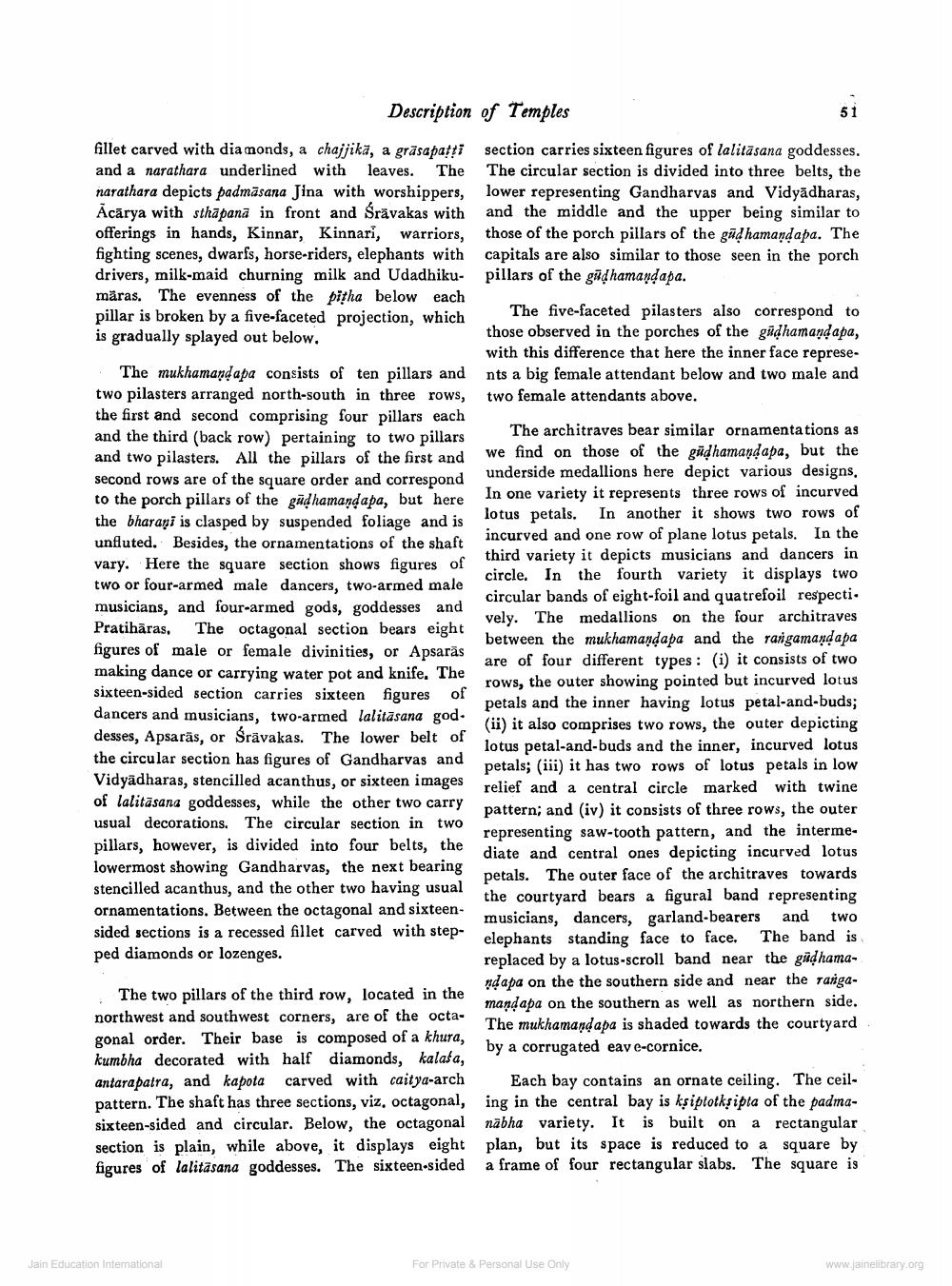________________
Description of Temples
fillet carved with diamonds, a chajjika, a gräsapatti section carries sixteen figures of lalitāsana goddesses. and a narathara underlined with leaves. The The circular section is divided into three belts, the narathara depicts padmāsana Jina with worshippers, lower representing Gandharvas and Vidyadharas, Acārya with sthapana in front and Srāvakas with and the middle and the upper being similar to offerings in hands, Kinnar, Kinnari, warriors, those of the porch pillars of the gūd hamandapa. The fighting scenes, dwarfs, horse-riders, elephants with capitals are also similar to those seen in the porch drivers, milk-maid churning milk and Udadhiku- pillars of the gādhamandapa. märas. The evenness of the pitha below each pillar is broken by a five-faceted projection, which
The five-faceted pilasters also correspond to is gradually splayed out below,
those observed in the porches of the gūdhamand apa,
with this difference that here the inner face represeThe mukhamandapa consists of ten pillars and nts a big female attendant below and two male and two pilasters arranged north-south in three rows, two female attendants above. the first and second comprising four pillars each and the third (back row) pertaining to two pillars
The architraves bear similar ornamentations as and two pilasters. All the pillars of the first and we find on those of the gūdhamandapa, but the second rows are of the square order and correspond
underside medallions here depict various designs, to the porch pillars of the gūdhamandapa, but here in one variety it represents three rows of incurved the bharani is clasped by suspended foliage and is
lotus petals. In another it shows two rows of unfluted. Besides, the ornamentations of the shaft
incurved and one row of plane lotus petals. In the vary. Here the square section shows figures of
third variety it depicts musicians and dancers in
circle. In the fourth variety it displays two two or four-armed male dancers, two-armed male
circular bands of eight-foil and quatrefoil respecti. musicians, and four-armed gods, goddesses and
vely. The medallions on the four architraves Pratihāras. The octagonal section bears eight
between the mukhamandapa and the rangamandapa figures of male or female divinities, or Apsaras making dance or carrying water pot and knife. The
are of four different types: (i) it consists of two sixteen-sided section carries sixteen
rows, the outer showing pointed but incurved lotus figures of
petals and the inner having lotus petal-and-buds; dancers and musicians, two-armed lalitasana god.
(ii) it also comprises two rows, the outer depicting desses, Apsaräs, or Srāvakas. The lower belt of
lotus petal-and-buds and the inner, incurved lotus the circular section has figures of Gandharvas and
petals; (iii) it has two rows of lotus petals in low Vidyadharas, stencilled acanthus, or sixteen images
relief and a central circle marked with twine of lalitasana goddesses, while the other two carry
pattern; and (iv) it consists of three rows, the outer usual decorations. The circular section in two
representing saw-tooth pattern, and the intermepillars, however, is divided into four belts, the
diate and central ones depicting incurved lotus lowermost showing Gandharvas, the next bearing
petals. The outer face of the architraves towards stencilled acanthus, and the other two having usual
the courtyard bears a figural band representing ornamentations. Between the octagonal and sixteen
musicians, dancers, garland-bearers and two sided sections is a recessed fillet carved with step
elephants standing face to face. The band is ped diamonds or lozenges.
replaced by a lotus-scroll band near the gudhama
udapa on the the southern side and near the raigaThe two pillars of the third row, located in the
mandapa on the southern as well as northern side. northwest and southwest corners, are of the octa
The mukhamand apa is shaded towards the courtyard gonal order. Their base is composed of a khura,
by a corrugated eav e-cornice. kumbha decorated with half diamonds, kalafa, antara patra, and kapota carved with caitya-arch Each bay contains an ornate ceiling. The ceilpattern. The shaft has three sections, viz, octagonal, ing in the central bay is ksiptotksipta of the padmasixteen-sided and circular. Below, the octagonal nabha variety. It is built on a rectangular section is plain, while above, it displays eight plan, but its space is reduced to a square by figures of lalitasana goddesses. The sixteen-sided a frame of four rectangular slabs. The square is
Jain Education International
For Private & Personal use only
www.jainelibrary.org




